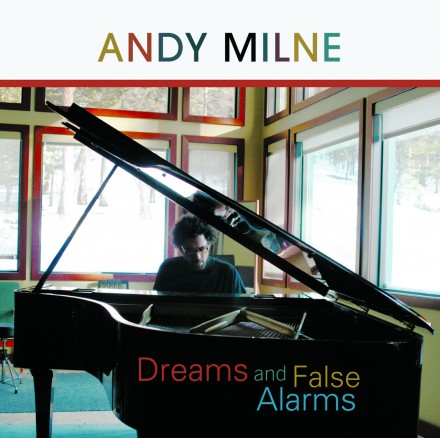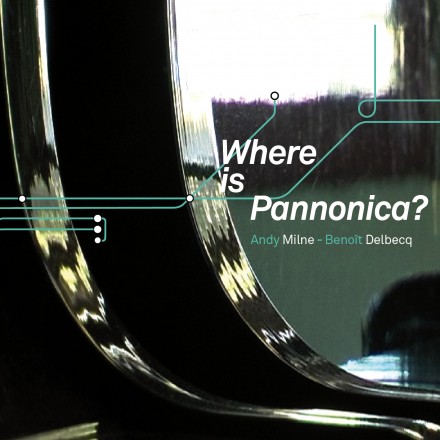Andy Milne
Dreams and False Alarms
SGL SA1565-2“Andy Milne is one of the truly original voices in the music world today. It’s hard for me to be delighted, surprised or shocked at what I hear anymore, but Andy manages to do it to me.”
—Kenny Werner
Canadian pianist and keyboard player Andy Milne has been based in the US since the early 90s, performing with Steve Coleman’s groups and with Cassandra Wilson, then leading his own quintet Dapp Theory, a band which combines jazz grooves with funk and hip-hop. But in the last couple of years he has been playing a lot more solo piano, which serendipitously has resulted in the simultaneous release of two piano records. Dreams and False Alarms contains deeply considered re-workings of long-remembered pop/rock/folk/reggae classics (and three originals), reaffirming and expanding his creative process as a jazz improviser, while Scenarios (Obliqsound), an intimate duo with harmonica virtuoso Gregoire Maret, presents a more textural, almost cinematic series of encounters – complementary expressions of a questing musical personality.
On Dreams, the social and artistic idealism which Milne brings to his work has influenced both his choice of music and its interpretation. “For me, I have to discover how I’m going to assume my own temporary ownership of a song before I can determine my approach. So in the case of these songs, I played them a bunch of different ways for a while, until a path revealed itself. If a path didn’t reveal itself, as was the case with “The Times They Are A-Changin’,” I stepped away from the piano and tried to re-compose the sonic space the song would occupy. I came up with the idea of using the singing Tibetan bowl on this tune because it offered a meditative quality which I felt complemented the spirit of the original Dylan recording. Deciding what songs to record wasn’t easy, but essentially I looked for material rich with meaningful, strong melodic content and just enough room for some personal harmonic development. What draws me to this music? I think it’s the combined artistry of the poetry, songwriting and performance of their creators. Artists like Bruce Cockburn, Bob Marley, and Joni Mitchell use their songs to speak about important things that need to be heard in this world, yesterday and today. I guess I’m drawn to them for their courage and ideology.”
“Dreams and False Alarms is actually taken from the refrain of ‘Amelia,’ the Joni Mitchell song which opens the CD. I chose it because I like how it expresses what we experience in our lives as we allow ourselves to grow and change. This CD represents a side of my musical self that, until recently, few listeners have had the opportunity to experience. It also marks a broadening of direction for me artistically and professionally. I guess I’m using the familiarity of these songs to float the listener back in time to different places in their (our) lives to remind them (us) of the idealism that existed whenever that was. We have so much information available to us in the digital age and our ability to store it expands daily. I think it’s important to remind ourselves that information isn’t necessarily the same as wisdom.”
In terms of style, Andy cites a long list of keyboard heroes and mentors, from Tatum, Monk, Oscar Peterson, Herbie Nichols, Ahmad Jamal, McCoy Tyner and Herbie Hancock to Muhal Richard Abrams, Mulgrew Miller, Geri Allen, Kenny Werner and Brad Mehldau, not forgetting Glenn Gould or Stevie Wonder. There’s a two-handed creative alchemy going on here though that Andy has been working on since his summer at the Banff jazz workshop in 1990 under Steve Coleman’s leadership. “These days it seems like every musician listens to a multiplicity of musical genres, or at least they frequently cite diverging influences in interviews. Blending those influences isn’t quite as easy as citing them. For me, my goal is to do it in ways that don’t sound contrived or insincere. Learning to work with who each of us is, while exploring the universe for inspiration and then expressing those things in creative and personal ways, is to me [a] humbling and inspiring thing….”
Dreams and False Alarms was recorded in the recital hall of UBC’s School of Music in Vancouver. In such a venue “there’s room to explore the entire range of the piano, because the instrument and the natural acoustics of the room dictate the dynamic range of the performance. Also, playing solo is proving to be a very liberating experience because I can give in to whimsical impulses at any given moment….The joy for me with both of these recordings was being able to express pianistic subtleties to a much greater extent than on Dapp Theory recordings…. Throughout this CD, an attempt was made to take the listener on a sonic as well as musical voyage. At times the mix shifts perspectives, enabling the listener to be in different positions in the room and perhaps even different points in history.” And with high-resolution recording and multi-channel mixing, each musical gesture contains subtle aural/emotional resonances.
**** “Milne’s resistance to creative stasis and the status quo help make each of his new releases intriguing in a different way than the last…A New Yorker by choice, Andy Milne apparently retains some of the pastoral temperament that draws from his Canadian birthright.” —Robert Doerschuk, DownBeat
****1/2 “Highly recommended.” — Ken Dryden, Allmusic.com
“Milne’s talent is unequivocal — he was saxophonist Steve Coleman’s pianist of choice for many years — so a solo session is an understandable and exciting new challenge for the gregarious former pupil of Canada’s northern stars Oscar Peterson and Don Thompson…The pianist takes off, unraveling newfound landscapes miles away from his usual urban, M-BASE base…while we anxiously wait for his next projects, one rests assured in the searching pianist’s ability to reach inspiring new plateaus.” — Martin Gladu, AllAboutJazz
“It’s probably best to approach this recording as an examination into Milne’s current state of harmonic construction. The way he overlaps and builds upper-partial chordal-units into blocks of almost polytonal complexity within the framework of 11 non-traditional jazz compositions is, while out of the ordinary, a worthwhile voyage…There is nothing vaguely approaching hard swing within, but for those looking for an intellectual yet heartfelt introspective approach to the music of today, Milne presents exciting possibilities…Highlights include a deeply moving version of Dylan’s ‘The Times They Are A-Changin’.’ Using an ostinato block-chord rhythmic figure as an underpinning, Milne places the melody’s fragments into a prism through which Dylan’s lines are rendered in one of the warmest renditions yet recorded. The all-too-short original ‘Sensei-tions’ is a marvelous nugget in the mode of Bartok’s short ‘Microcosmos.’…Looking back years from now, one can’t but believe this anthology of works will be one of his most cherished.” — Thomas R. Erdman, Jazzreview.com
“Jazz musicians have a long-standing tradition of using popular songs as a basis for both composition and improvisation….Pianist Andy Milne adds some surprises to this legacy…For instance, who knew that there was some Monk to be found in the harmonic structure of Joni Mitchell’s ‘Amelia’? A dark elegance is brought out of ‘Message In A Bottle,’ performed as a dirgy blues…The centerpiece of this collection is the reworking of ‘The Times They Are A Changin.’ Beginning with a Tibetan singing bowl strike, that familiar melody is slowly brought forth before dissolving into a four-chord ostinato. With that insistent singing bowl floating over everything, it’s tough to not think of the universal appeal of the original song’s message. It’s somehow comforting to me to know that there are others out there who can draw a thread through so many disparate elements of life, to know that music in particular is an integral part of life as opposed to just some ancillary activity. Miles and Coltrane knew it. Add one to the list.” — Mark Saleksi, Blogcritics.org
“A strong focused statement from an excellent improviser who understands something of the art of writing, its jazz, classical and pop manifestations and what might make a real composition more than a pattern of notes…Milne uses his well-weighted, communicative touch at the keyboard to ensure that the story of the song is not lost in a blizzard of sound, as can often by the case when solo performers see silence as adversary rather than ally.” — Jazzwise (UK)

